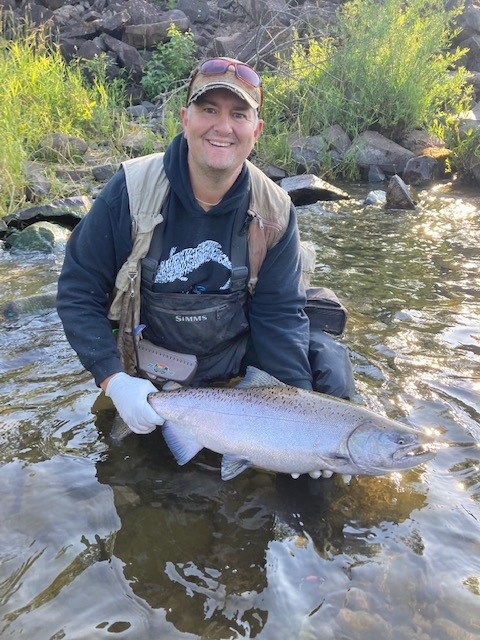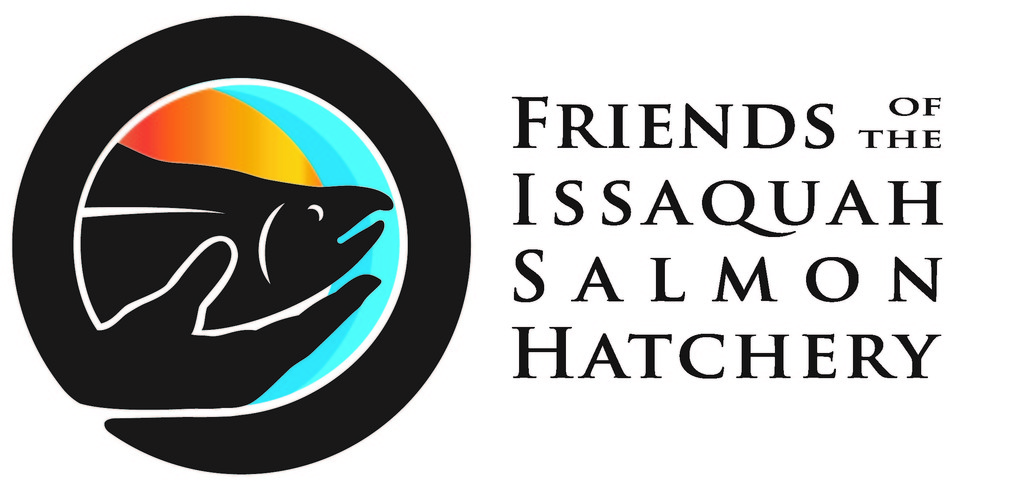Brodie Antipa: Promoting Partnerships
Brodie Antipa: Promoting Partnerships
By Grace Reamer
As the Friends of the Issaquah Salmon Hatchery celebrates its 30th anniversary, we are taking a look back at the people and the activities that brought about the formation and development of this unique organization and partnership.
The Issaquah Salmon Hatchery didn’t have much to recommend itself back in 1995, when Brodie Antipa first arrived. The aging incubation building needed a new roof and new equipment, and the old asphalt holding ponds were inefficient and difficult to manage adult spawning salmon.
“It was quite a bit more sterile than it is now,” with no signage or art or gardens or educational exhibits, Antipa said. “It was kind of dark and dreary.”
But change was starting. The old wooden weir – the fish passage barrier across Issaquah Creek – had just been replaced with a high-tech variable-height weir, thanks to matching funding from the City of Issaquah and the State of Washington. After it was threatened with closure, the hatchery was rescued through a community-wide lobbying effort to rebuild the facility as an education center. The first phase of the transformation had begun, and Antipa had been hand-picked to manage the hatchery and shepherd the next phases of the remodeling project.
“Mike Lewis had just left (as hatchery manager), and they knew what an important position it was,” with the new mission of the hatchery to deliver an environmental conservation message, Antipa said. “I knew how important it was going into it, and I knew that failure wasn’t an option. It didn’t take me long to realize that the hatchery was unique in many ways.”
At just 25 years old, Antipa was the new blood that the state Department of Fish and Wildlife sought to breathe new life into the 60-year-old hatchery. He practically grew up in the Fisheries Department, following the lead of his father, a state fisheries pathologist with a doctorate from the University of Washington.
Growing up in the Seattle and Olympia areas, “I always loved to be outside fishing and working with the fish,” Antipa remembered. Just like his father, he completed his fisheries degree at the UW, and immediately went to work as a biologist at the Cedar River Hatchery, where DFW’s sockeye program was just getting started. In fact, he continued his sockeye work on the Cedar part-time while managing the Issaquah hatchery.
He remembered being awe-struck by the huge support network he found surrounding the Issaquah hatchery – with city officials, state politicians, businesses, the Muckleshoot Tribe, non-profit organizations and community volunteers all working together to save and promote the hatchery.
“I don’t think of any other time in my career when I’ve seen such a collaboration,” Antipa said. “The volunteers were so awesome back then – a lot of laughter and a lot of smiles. We simply couldn’t do it at Issaquah without volunteers.”
He has fond memories of the volunteer business owners mobilized by Chamber of Commerce Director Suzanne Suther to plant flowers and spruce up garden beds at the hatchery. Issaquah Salmon Days Festival Director Robin Kelley always helped him get the hatchery ready for the annual festival that hosted up to 200,000 people on the first weekend in October.
He also credits Steve Bell, founder and first executive director of the non-profit Friends of the Issaquah Salmon Hatchery, for mentoring him, lobbying for grants and funding, and coordinating exhibit installations as well as the educational programming. Antipa learned to focus on the partnerships and the team effort that would make the hatchery and its messaging so successful, he said.
“We’ve known for a long time that hatcheries are necessary if you want to have cities and urban development,” Antipa said. But the state didn’t have a way to share that message with the public, until the proposal to use the Issaquah hatchery for outreach about environmental stewardship. “It was a real wake-up call for the department. Society has traded the habitat for development, and that’s the story that the hatchery can tell. Issaquah was really the first place to do it that I’m aware of in Washington.”
But it was a challenge. In the economic downturn of the mid-1990s, it wasn’t easy to justify the $6.5 million that the state eventually dedicated to three phases of redevelopment at the hatchery. The partnerships that Antipa and Bell cultivated kept the project moving forward, replacing the underground fish ladder with a longer ladder and underwater viewing windows. The old shallow holding ponds, where volunteers waded into the water with big nets to corral fish for harvesting eggs, were replaced with deeper ponds and automated crowders that improved fish survival. A new pedestrian bridge, twice as wide, was dropped into place by crane over Issaquah Creek, and new coho rearing ponds were dug on the south side. Best of all was the remodel of the historic incubation building, with its long row of windows and high-pitched roof, which got new equipment and roofing while maintaining the original appearance of the building.
“These old hatchery buildings just have a certain character that you can’t replace with a metal building,” Antipa said. “You almost feel a spirit within the building.”
In his nearly five years at the Issaquah hatchery, Antipa worked with the city on a partnership with the Darigold plant a few blocks away. That effort resulted in the installation of a waterline carrying pure well water that Darigold used to chill its butter to the hatchery, instead of just dumping it in the creek. At the hatchery, that pure water is mixed with creek water and used to incubate millions of salmon eggs, reducing the amount of sediment and pollutants bathing the incubation trays.
In 2000, Antipa was promoted to the complex management position for the Lake Washington drainage area, and then went on to serve as a hatchery reform coordinator. He’s now moved up to hatchery operations manager for all the facilities from Tokul Creek in Fall City down through the Green River system, where he works on reform efforts and changing policies based on new biological opinions and science.
So in 2020, it was Antipa who Kelley called in her new capacity as FISH’s executive director when the pandemic shut down public access to the hatchery. Because of the need for 24-hour on-call status for the three-person staff, complete closure was deemed necessary to reduce the risk of life-threatening illness. But Kelley proposed limited tours of small groups, with masking required, to meet the huge demand for safer, outdoor activities.
“This is going to be a hard sell,” Antipa told her. But his previous experience with the FISH organization assured him that they could do it safely, and he eventually got state permission for the tour program. “It took some time,” he said, “but Issaquah was then the only place in the state giving tours, and that was because of FISH.”
When he arrived nearly 30 years ago, FISH had a small core of volunteers helping with spawning and leading tours for students in the fall. Since then, with DFW support, FISH education programs have expanded to year-round, including spring science fairs and summer camps and a gift shop, along with a roster of more than 100 volunteers.
“I think there’s a huge value in what FISH has done to tell the story of salmon to the masses, to the people who wouldn’t normally hear it,” especially in how students learn about the links between salmon and their environment, Antipa said. “FISH is filling a niche and creating that value that wasn’t here before. You think about the magnitude and the number of people who have got exposure at the hatchery – it’s monumental. We can’t put a price on that.”

